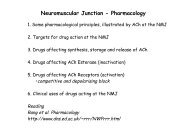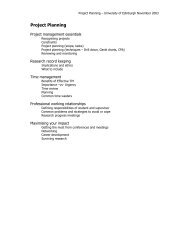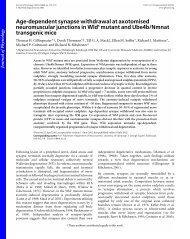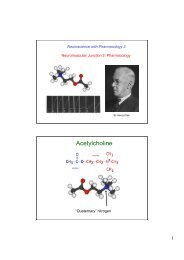Physiology and Pathophysiology of Neuromuscular Transmission
Physiology and Pathophysiology of Neuromuscular Transmission
Physiology and Pathophysiology of Neuromuscular Transmission
Create successful ePaper yourself
Turn your PDF publications into a flip-book with our unique Google optimized e-Paper software.
<strong>Physiology</strong> <strong>and</strong> <strong>Pathophysiology</strong> <strong>of</strong><br />
<strong>Neuromuscular</strong> <strong>Transmission</strong><br />
“The neuromuscular<br />
junction... [is] an<br />
experimentally favourable<br />
object whose study could<br />
throw considerable light<br />
on synaptic mechanisms<br />
elsewhere”<br />
Sir Bernard Katz, Fenn<br />
Lecture, IUPS Glasgow,<br />
1993<br />
http://www.ricercaitaliana.it/prin/dettaglio_completo_prin_en-2004053317.htm<br />
1
Proteins <strong>of</strong> the Active Zone<br />
http://en.wikipedia.org/wiki/Active_zone<br />
Tools for studying synaptic form <strong>and</strong> function<br />
2
‘Bassoon’ immunostaining localises to active zones<br />
Nishimune et al. (2004) Nature 432:580-587.<br />
Ca imaging during high frequency stimulation<br />
Pseudocoloured<br />
Surface Plot<br />
Greg Lnenicka<br />
Measuring exocytosis with “synaptopHluorin”<br />
O<br />
OH<br />
N N λ abs = 397 nm<br />
OH<br />
O HN<br />
- H + + H +<br />
O<br />
O -<br />
N N λ abs = 475 nm<br />
OH<br />
O HN<br />
chromophore<br />
3
Recycling vesicles take up fluorescent styryl (“FM”) dyes<br />
Hydrophobic<br />
hν<br />
Hydrophilic<br />
Bewick<br />
Desaki & Uehara, 1981<br />
4
Typically-measured characteristics <strong>of</strong> the EPP (or MEPP)<br />
Rise Time<br />
(1-2 ms) Half-decay Time<br />
(2-3 ms)<br />
Amplitude<br />
(1-40 mV)<br />
Ch.2<br />
Latency<br />
(1-2 ms)<br />
10 mV<br />
5.00 ms<br />
Action potentials are “all-or-nothing” signals...<br />
… but EPPs are variable responses<br />
4<br />
3<br />
2<br />
Ch0<br />
1<br />
0<br />
-5 mV<br />
5.00 ms<br />
Quantal size<br />
= Effect <strong>of</strong> one vesicle released<br />
Quantal content = Number <strong>of</strong> vesicles released<br />
5
EPP’s show short-term plasticity<br />
Facilitation<br />
5 ms<br />
Short-term Depression<br />
10 mV<br />
Gillingwater<br />
300 ms<br />
D. Thomson<br />
<strong>Physiology</strong> <strong>and</strong> <strong>Pathophysiology</strong> <strong>of</strong><br />
<strong>Neuromuscular</strong> <strong>Transmission</strong><br />
1. Botulism <strong>and</strong> Myasthenias<br />
2. Characteristics <strong>of</strong> MEPPS <strong>and</strong> EPPS<br />
3. Quantal analysis<br />
4. Safety factor <strong>and</strong> size-strength relationships<br />
<strong>Physiology</strong> <strong>and</strong> <strong>Pathophysiology</strong> <strong>of</strong><br />
<strong>Neuromuscular</strong> <strong>Transmission</strong><br />
1. Botulism <strong>and</strong> Myasthenias<br />
2. Characteristics <strong>of</strong> MEPPS <strong>and</strong> EPPS<br />
3. Quantal analysis<br />
4. Safety factor <strong>and</strong> size-strength relationships<br />
6
Botulinum toxins cleave SNARE proteins<br />
Myasthenia gravis <strong>and</strong> LEMS are autoimmune diseases<br />
LEMS: Ca channel<br />
antibodies<br />
X<br />
X<br />
X<br />
X<br />
MG: AChR<br />
antibodies<br />
EPP’s teeter on the brink <strong>of</strong> the muscle fibre<br />
action potential firing threshold in myasthenias<br />
7
Lambert-Eaton Myasthenic Syndrome<br />
• Weight loss<br />
• Slurred speech<br />
• Weak shoulder abduction <strong>and</strong> hip flexion<br />
• Reflexes absent, but re-appear after exercise<br />
• Sensation normal<br />
Complete recording from one LEMS patient demonstrating an initial small resting<br />
compound muscle action potential(CMAP), followed by a 10-second period <strong>of</strong> maximal<br />
voluntary contraction <strong>and</strong> subsequently 30 CMAPs illustrating augmentation <strong>and</strong><br />
exponential decay.<br />
Maddison P et al. Neurology 1998;50:1083-1087<br />
0 Ca Direct +Ca +4AP +Mg +4AP Direct TTX<br />
8
Myasthenia Gravis<br />
Before<br />
• Bilateral ptosis<br />
• Double vision in all directions<br />
• Fatiguable weakness<br />
• Reflexes disappear after exercise<br />
• Sensation normal<br />
After edrophonium<br />
(Tensilon Test)<br />
dTC dTC neo sux sux sux neo direct<br />
Pre- <strong>and</strong> post-synaptic abnormalities have distinctive effects on EPPs<br />
Synaptic Facilitation<br />
- Impaired presynaptic function<br />
Low quantal content<br />
(normal postsynaptic function)<br />
Synaptic Depression<br />
- Normal presynaptic function<br />
Normal quantal content<br />
(impaired postsynaptic function)<br />
9
Lambert-Eaton Myasthenic Syndrome<br />
EMG<br />
EPP<br />
Normal<br />
LEMS<br />
EPPs have low quantal content<br />
<strong>and</strong> show facilitation<br />
Myasthenia gravis<br />
EMG<br />
Intracellular recording - NMJ<br />
Summary <strong>of</strong> electrophysiological changes in<br />
Myasthenia Gravis <strong>and</strong> Myasthenic Syndrome<br />
50<br />
(NI=Normal Individual)<br />
10
C h.0<br />
5 m V<br />
C h .0<br />
5 m V<br />
5 .0 0 m s<br />
5 .0 0 m s<br />
C h .0<br />
C h .0<br />
5 m V<br />
5 m V<br />
5 .0 0 m s<br />
5 .0 0 m s<br />
Anticholinesterases increase EPP amplitude <strong>and</strong> prolong EPP decay time<br />
Control<br />
Neostigmine (5 µM)<br />
Kosala Dissanayake<br />
<strong>Physiology</strong> <strong>and</strong> <strong>Pathophysiology</strong> <strong>of</strong><br />
<strong>Neuromuscular</strong> <strong>Transmission</strong><br />
1. Botulism <strong>and</strong> Myasthenias<br />
2. Characteristics <strong>of</strong> MEPPS <strong>and</strong> EPPS<br />
3. Quantal analysis<br />
4. Synaptic strength <strong>and</strong> safety factor<br />
Desaki & Uehara, 1981, J Neurocytol 10,101<br />
11
MEPPs (aka ‘minis’) are independent events<br />
that occur with low release probability. This<br />
generates <strong>and</strong> exponential, Poisson distribution<br />
<strong>of</strong> intervals between events.<br />
If the mean frequency is m (s -1 ), then the<br />
frequency <strong>of</strong> a given number <strong>of</strong> MEPPs, x, in<br />
each one second raster sweep is given by:<br />
P(x) = exp(!m). m x<br />
x!<br />
Mini analysis<br />
Amplitude<br />
y = exp(!(x ! µ) 2 / 2" 2 ) / (" 2# )<br />
Interval<br />
Fatt & Katz, 1952, JPhysiol<br />
MEPP<br />
EPP<br />
12
<strong>Physiology</strong> <strong>and</strong> <strong>Pathophysiology</strong> <strong>of</strong><br />
<strong>Neuromuscular</strong> <strong>Transmission</strong><br />
1. Botulism <strong>and</strong> Myasthenias<br />
2. Characteristics <strong>of</strong> MEPPS <strong>and</strong> EPPS<br />
3. Quantal analysis<br />
4. Synaptic strength <strong>and</strong> safety factor<br />
Measuring EPP’s….<br />
X<br />
Action potential<br />
…add µ-conotoxin<br />
…add d-tubocurarine<br />
13
EPP’s<br />
(muscle action potential blocked)<br />
EPP’s in low Ca/high Mg<br />
Mg 2+<br />
Ca 2+<br />
5 mV<br />
10.00 ms<br />
5 mV<br />
10.00 ms<br />
Binomial model:<br />
Let:<br />
n=3<br />
p= 0.17<br />
(q=1-p)<br />
m=n.p<br />
P(0) = ?<br />
P(1) = ?<br />
P(2) = ?<br />
P(3) = ?<br />
14
Binomial model:<br />
Let:<br />
n=3<br />
p= 0.17<br />
(q=1-p)<br />
m=n.p<br />
P(0) = q 3<br />
P(1) = 3pq 2<br />
P(2) = 3p 2 q<br />
P(3) = p 3<br />
P(x) =<br />
n!<br />
x!(n ! x)! p x (n ! x)<br />
.q<br />
Let :<br />
x
P(x) = exp(!m). m x<br />
Poisson Distribution<br />
x!<br />
P(0) = exp(-m)<br />
P(1) = m.exp(-m)<br />
P(2) = m 2 .exp(-m)/2<br />
P(3) = m 3 .exp(-m)/6<br />
“God does not play dice ”<br />
Simulation:Excel<br />
16
Poisson distribution <strong>of</strong> Quantal<br />
Contents <strong>of</strong> EPPs (n=100 trials)<br />
40<br />
Frequency<br />
30<br />
20<br />
10<br />
m=1<br />
0<br />
0 1 2 3 4 5 6 7 8 9 10 11 12<br />
Quantal content<br />
Poisson distribution <strong>of</strong> Quantal<br />
Contents <strong>of</strong> EPPs (n=100 trials)<br />
40<br />
m=2<br />
Frequency<br />
30<br />
20<br />
10<br />
0<br />
0 1 2 3 4 5 6 7 8 9 10 11 12<br />
Quantal content<br />
Poisson distribution <strong>of</strong> Quantal<br />
Contents <strong>of</strong> EPPs (n=100 trials)<br />
40<br />
m=3<br />
Frequency<br />
30<br />
20<br />
10<br />
0<br />
0 1 2 3 4 5 6 7 8 9 10 11 12<br />
Quantal content<br />
17
Poisson distribution <strong>of</strong> Quantal<br />
Contents <strong>of</strong> EPPs (n=100 trials)<br />
40<br />
m=4<br />
Frequency<br />
30<br />
20<br />
10<br />
0<br />
0 1 2 3 4 5 6 7 8 9 10 11 12<br />
Quantal content<br />
Poisson distribution <strong>of</strong> Quantal<br />
Contents <strong>of</strong> EPPs (n=100 trials)<br />
40<br />
m=5<br />
Frequency<br />
30<br />
20<br />
10<br />
0<br />
0 1 2 3 4 5 6 7 8 9 10 11 12<br />
Quantal content<br />
Methods <strong>of</strong> quantal analysis:<br />
1. Direct method : m=EPP/MEPP (better, EPC/MEPPC)<br />
2. Failures method: P(0)=exp(-m); m=Ln(Tests/Failures)<br />
( for binomial: P(0)=(1-p) n )<br />
3. Variance method: m = 1/(C.V.) 2 i.e. m=EPP 2 /var(EPP)<br />
(for binomial: var(m)=npq)<br />
18
Problems<br />
- Non-Poisson conditions<br />
- MEPP variance<br />
- Non-linear summation<br />
Problems<br />
- Non-Poisson conditions<br />
- MEPP variance<br />
- Non-linear summation<br />
19
Binomial statistics are a better predictor or<br />
response variability when p>0.1<br />
p=0.044<br />
p=0.49<br />
Problems<br />
- Non-Poisson conditions<br />
- MEPP variance<br />
- Non-linear summation<br />
20
The Normal (Gaussian) Distribution<br />
y = exp(!(x ! µ) 2 / 2" 2 ) / (" 2# )<br />
y<br />
(!x 2 )<br />
# % exp $<br />
&<br />
2"<br />
0.25<br />
y = 5<br />
0.5 2'<br />
(µ = 0; σ =0.5)<br />
x<br />
n<br />
+<br />
P(x) = " exp(!m) mx<br />
.-<br />
k =1 x! ,-<br />
1 % !( x ! kx ) 2 (.<br />
2#k$ 2 '<br />
0<br />
& 2k$ 2 *<br />
)/<br />
0<br />
10 ' exp (! 3)<br />
" 3 x<br />
y 15 % ' &<br />
( 1 '!<br />
( x ! 1.1k) 2 (<br />
% ' exp<br />
# x! $<br />
0.2 2)k # %<br />
2k0.2 2 $ & &<br />
( (<br />
= * % &<br />
# # $ $<br />
k = 1<br />
m=3 quanta<br />
σ= 0.2 mv<br />
x =1.1mv<br />
21
MEPP<br />
EPP<br />
Quantal analysis<br />
P x<br />
= e!m m x<br />
x!<br />
MEPPs<br />
EPPs<br />
Stim.<br />
Quantal Size:<br />
Quantal Content:<br />
q = MEPP<br />
m = EPP<br />
q<br />
Problems<br />
- Non-Poisson conditions<br />
- MEPP variance<br />
- Non-linear summation<br />
The ACh null-potential (reversal potential) is about -10 mV<br />
22
V<br />
~<br />
I<br />
Desaki & Uehara, 1981, J Neurocytol 10,101<br />
R<br />
R m<br />
C m<br />
E ACh<br />
R i<br />
2 ms<br />
200,000 channels<br />
End-Plate Current (EPC)<br />
End-Plate Potential (EPP)<br />
20 mV<br />
23
EPC’s sum linearly : EPP’s sum non-linearly<br />
McLachlan EM, Martin AR. Non-linear summation <strong>of</strong> end-plate potentials in the frog<br />
<strong>and</strong> mouse. J Physiol. 1981 Feb;311:307-24.PMID: 6267255<br />
Correction Factors<br />
Martin (1955):<br />
v' = v /(1! v /(E m<br />
! E r<br />
)<br />
m =<br />
q(1 ! v ! (E m<br />
! E r<br />
)<br />
v= EPP amplitude<br />
q= MEPP amplitude<br />
m = quantal content<br />
v' = v /(1! fv(E m<br />
! E r<br />
)<br />
v !<br />
McLachlan & Martin (1981)<br />
Where f = an empirically determined ('fudge’) factor<br />
For mouse muscle, long fibres: f=0.8<br />
For frog muscle, long fibres: f=0.55<br />
For short muscle fibres (e.g. FDB) the correction is unknown, but<br />
f=0.3 gives a good fit to our data.<br />
<strong>Physiology</strong> <strong>and</strong> <strong>Pathophysiology</strong> <strong>of</strong><br />
<strong>Neuromuscular</strong> <strong>Transmission</strong><br />
1. Botulism <strong>and</strong> Myasthenias<br />
2. Characteristics <strong>of</strong> MEPPS <strong>and</strong> EPPS<br />
3. Quantal analysis<br />
4. Synaptic strength <strong>and</strong> safety factor<br />
24
NMJ have a high ‘safety factor’<br />
<strong>Physiology</strong> <strong>and</strong> <strong>Pathophysiology</strong> <strong>of</strong><br />
<strong>Neuromuscular</strong> <strong>Transmission</strong><br />
1. Botulism <strong>and</strong> Myasthenias<br />
2. Characteristics <strong>of</strong> MEPPS <strong>and</strong> EPPS<br />
3. Quantal analysis<br />
4. Synaptic strength <strong>and</strong> safety factor<br />
- Nerve terminal size<br />
- Quantal content per unit area<br />
- MEPP amplitude<br />
- “Input resistance”<br />
EPP amplitude is proportional to nerve terminal area<br />
RH414/FM1-43<br />
20 µm<br />
10 ms<br />
Costanzo et al.(1999) J Physiol 521:365-74<br />
25
NMJ size <strong>and</strong> muscle mibre diameter are correlated<br />
Specific quantal content (m/µm 2 ) is constant<br />
A<br />
B<br />
100<br />
80<br />
1<br />
60<br />
40<br />
-2<br />
) mµ<br />
m/a<br />
(µm -2 ) 0.1<br />
%Occupancy<br />
% Occupancy<br />
20<br />
0<br />
sub super<br />
m/a (<br />
0.01<br />
sub-sub sub-super super-super<br />
Costanzo et al.(1999) J Physiol 521:365-74<br />
Species<br />
Quantal content<br />
Frog<br />
Rat<br />
Frog 200<br />
Rat, mouse 50-75<br />
Man 20-30<br />
Man<br />
26
Vm<br />
2.5 mV<br />
Vm<br />
Ch.2<br />
2.5 mV<br />
1 mV<br />
Ch.2<br />
31 Keyboard<br />
AC<br />
mV<br />
1<br />
6<br />
1 mV<br />
5<br />
4<br />
3<br />
2<br />
Ch.2<br />
10 mV<br />
10.00 ms<br />
10.00 ms<br />
85 90 95 100 105 110 115 120 125 130 135 140 145<br />
5.00 ms<br />
s<br />
Vm<br />
2.5 mV<br />
Ch.2<br />
1 mV<br />
10.00 ms<br />
AC<br />
mV<br />
1<br />
0<br />
-2<br />
-4<br />
-6<br />
-10<br />
-8<br />
Ch.2<br />
10 mV<br />
5.00 ms<br />
190 200 210 220 230 240 250 260 270 280 290<br />
s<br />
Evoked release <strong>and</strong> NMJ area are correlated<br />
200<br />
Frog<br />
150<br />
100<br />
50<br />
0<br />
0 250 500 750 1000 1250 1500<br />
Synaptic area<br />
Rat<br />
Man<br />
The size <strong>of</strong> NMJ <strong>and</strong> the extent <strong>of</strong> junctional folding vary between species<br />
Frog<br />
Frog<br />
Rat<br />
Rat<br />
Man<br />
Man<br />
Synaptic size-strength regulation compensates for diameter-input resistance<br />
nt<br />
mf<br />
R in<br />
= 1 R m<br />
R i<br />
A ! d 3<br />
t<br />
! d m<br />
V<br />
10 mV<br />
2 nA<br />
I<br />
=<br />
R in<br />
20 ms<br />
q ! R in<br />
MEPPs<br />
m ! A t<br />
EPPs<br />
27
R in<br />
Harris & Ribchester (1979) J Physiol 296, 245-265<br />
Endplate area, fibre diameter <strong>and</strong> MEPP amplitude, frequency are correlated<br />
Quantal size (q) = response to a single vesicular release<br />
(i.e. the amplitude <strong>of</strong> the spontaneous MEPP)<br />
Abnormalities in quantal size indicate a postsynaptic problem<br />
Quantal content (m) = amount <strong>of</strong> transmitter released<br />
(i.e. the number <strong>of</strong> synaptic vesicles producing an EPP)<br />
Abnormalities in quantal content indicate a presynaptic problem<br />
<strong>Neuromuscular</strong> Junction: postsynaptic<br />
http://neuromuscular.wustl.edu/musdist/dag2.htm<br />
28
Congenital Myasthenic Syndromes<br />
Palace & Beeson (2008) J Neuroimmunol<br />
SUMMARY<br />
1. Variation in MEPP interval <strong>and</strong> EPP amplitude<br />
conforms to a Poisson Distribution<br />
2. Quantal content <strong>of</strong> EPP’s can be estimated by<br />
Direct, ‘Failures’, <strong>and</strong> Variance Methods.<br />
Remember to make allowance, if necessary, for<br />
non-linear summation <strong>of</strong> synaptic potentials<br />
3. Quantal content at rodent NMJ’s is about 50 <strong>and</strong><br />
the ‘safety factor’ is about 3.<br />
4. Determinants <strong>of</strong> synaptic strength <strong>and</strong> safetyfactor<br />
at the NMJ include Ca sensitivity (LEMS),<br />
ACh receptor density (MG), endplate size<br />
(CMS), <strong>and</strong> muscle fibre size (input resistance),<br />
29








